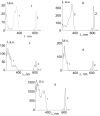New Copolymers of Vinylphosphonic Acid with Hydrophilic Monomers and Their Eu3+ Complexes
- PMID: 35160579
- PMCID: PMC8838993
- DOI: 10.3390/polym14030590
New Copolymers of Vinylphosphonic Acid with Hydrophilic Monomers and Their Eu3+ Complexes
Abstract
Free radical copolymerization is used for the synthesis of novel water-soluble copolymers of vinylphosphonic acid with 2-deoxy-2-methacrylamido-D-glucose or 4-acryloylmorpholine, with varied compositions and molecular masses, as well as for the synthesis of copolymers of vinylphosphonic acid with acrylamide. The obtained copolymers contain 6-97 mol.% of vinylphosphonic acid units, and their molecular masses vary from 5 × 103 to 310 × 103. The monomer reactivity ratios of vinylphosphonic acid and 2-deoxy-2-methacrylamido-D-glucose in copolymerization are determined for the first time, and their values are 0.04 and 9.02, correspondingly. It is demonstrated that the synthesized copolymers form luminescent mixed-ligand complexes with Eu3+, thenoyltrifluoroacetone, and phenanthroline. The influence of the comonomer's nature on the intensity of the luminescence of complex solutions is revealed.
Keywords: 2-deoxy-2-methacrylamido-D-glucose; 4-acryloylmorpholine; complexes of Eu3+; water-soluble copolymers of vinylphosphonic acid.
Conflict of interest statement
The authors declare no conflict of interest.
Figures










Similar articles
-
Synthesis and Anti-influenza Activity of Vinylphosphonic Acid (Co)polymers.Dokl Biochem Biophys. 2022 Oct;506(1):227-230. doi: 10.1134/S1607672922050155. Epub 2022 Oct 27. Dokl Biochem Biophys. 2022. PMID: 36303058 Free PMC article.
-
Self-Assembled Nanoparticles Based on Block-Copolymers of Poly(2-Deoxy-2-methacrylamido-d-glucose)/Poly(N-Vinyl Succinamic Acid) with Poly(O-Cholesteryl Methacrylate) for Delivery of Hydrophobic Drugs.Int J Mol Sci. 2021 Oct 24;22(21):11457. doi: 10.3390/ijms222111457. Int J Mol Sci. 2021. PMID: 34768888 Free PMC article.
-
Anhydrous proton-conducting properties of triazole-phosphonic acid copolymers: a combined study with MAS NMR.Phys Chem Chem Phys. 2008 Oct 21;10(39):6058-66. doi: 10.1039/b807659f. Epub 2008 Aug 20. Phys Chem Chem Phys. 2008. PMID: 18825294
-
Interpolymer Complexes of Poly(methacryloyloxyethyl phosphorylcholine) and Polyacids.Polymers (Basel). 2022 Jan 20;14(3):407. doi: 10.3390/polym14030407. Polymers (Basel). 2022. PMID: 35160398 Free PMC article.
-
Glucose oxidase and glucose for redox-initiating the free radical copolymerization of N-(ferrocenoylmethyl)acrylamide in aqueous cyclodextrin solution.Macromol Rapid Commun. 2015 Mar;36(5):427-31. doi: 10.1002/marc.201400612. Epub 2015 Jan 19. Macromol Rapid Commun. 2015. PMID: 25598173
Cited by
-
Design, Synthesis and Actual Applications of the Polymers Containing Acidic P-OH Fragments: Part 2-Sidechain Phosphorus-Containing Polyacids.Int J Mol Sci. 2023 Jan 13;24(2):1613. doi: 10.3390/ijms24021613. Int J Mol Sci. 2023. PMID: 36675149 Free PMC article. Review.
References
-
- Macarie L., Ilia G. Poly(Vinylphosphonic Acid) and Its Derivatives. Prog. Polym. Sci. 2010;35:1078–1092. doi: 10.1016/j.progpolymsci.2010.04.001. - DOI
-
- Ingratta M., Elomaa M., Jannasch P. Grafting Poly(Phenylene Oxide) with Poly(Vinylphosphonic Acid) for Fuel Cell Membranes. Polym. Chem. 2010;1:739. doi: 10.1039/b9py00390h. - DOI
-
- Dey R.E., Zhong X., Youle P.J., Wang Q.G., Wimpenny I., Downes S., Hoyland J.A., Watts D.C., Gough J.E., Budd P.M. Synthesis and Characterization of Poly(Vinylphosphonic Acid- Co -Acrylic Acid) Copolymers for Application in Bone Tissue Scaffolds. Macromolecules. 2016;49:2656–2662. doi: 10.1021/acs.macromol.5b02594. - DOI
Grants and funding
LinkOut - more resources
Full Text Sources

